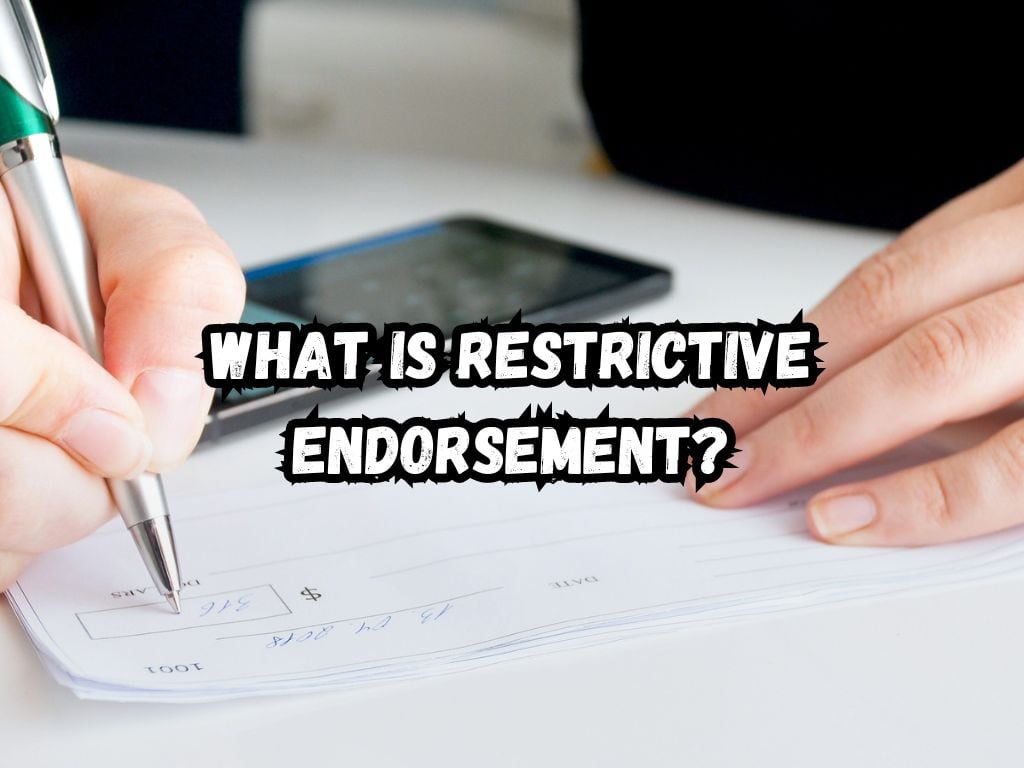When it comes to checks and the banking world, it’s crucial to understand different types of endorsements. Of these, one kind stands out for its unique security feature: the restrictive endorsement.
What is Restrictive Endorsement?
In essence, a restrictive endorsement is a way to limit the use of a check or other negotiable instrument. It’s used as a safety measure alongside the standard types, which include blank and special endorsements.
Unlike these common forms, the restrictive type provides added control over the transaction process.
This increased control is what sets it apart and makes it a vital weapon for individuals and businesses looking to minimize their risk of fraud.
The Concept and Application of Restrictive Endorsement
Definition
A restrictive endorsement is a safety provision. It instructs the bank on how to handle the document by imposing certain limitations.
Compare this to a blank endorsement, where the document can be cashed or deposited by anyone, or a special endorsement, where it’s designated to a specific person. The restrictive one provides tighter controls, backed by a firm legal foundation.

Purpose and Benefits
Why should one consider a restrictive endorsement? First and foremost, it is about security and control. By assigning clear directions for the bank, individuals or firms can guide the process of cashing or depositing checks.
This feature is especially handy in warding off unauthorized transactions, thereby mitigating fraud risk.
Common types include “For deposit only” and “For deposit to account number xxxxx”, each adding a layer of specificity to control where the funds end up.
Another form, conditional endorsements, serve a unique purpose – making the transaction dependent on specific conditions, which bring legal implications of their own.
How to Make a Restrictive Endorsement?
Steps and Guidelines
Crafting a restrictive endorsement is a relatively straightforward process. First, the document is turned over. The back usually has a dedicated space for this.
Here, the endorser writes their instructions, like “For deposit only” and includes any needed details such as account numbers.
It’s also crucial to remember possible mistakes. These include unclear handwriting, omitting vital details, and overlooking legal or policy boundaries. Respecting these errors adds to the robustness of the restrictive endorsement.
Best Practices
Some secrets to a good restrictive endorsement rely on simplicity. A good endorsement begins with clear handwriting and suitable ink usage.
Following this, specific account numbers and transaction details need to be presented accurately. An understanding of the applicable law and banking regulation is a must.
Applications in Business and Banking
Here’s why this matters in real-world scenarios, for both businesses and banks alike.
In Business Transactions
Businesses regularly employ restrictive endorsements in their transactions, with payroll and accounts payable being the common areas. Here, the endorsement serves as a safeguard against improper or unauthorized dealing with the business’s funds.
In Banking
Banks themselves count on restrictive endorsements for enhancing their process’s reliability. Specific rules are in place for deciphering and enforcing these endorsements.
A core area where these are vital is in fraud prevention, adding a strong layer of security to routine transactions.
Challenges and Considerations
Let’s delve into two key areas of consideration: limitations and laws.
Limitations
While helpful, restrictive endorsements are not always the perfect solution. There are times when their use isn’t appropriate or even accepted by the banking institution.
And with their use comes potential complications, which need keen attentiveness to handle.
Legal and Compliance Issues
Understanding the legal framework for restrictive endorsements is critical. This includes knowing the state-wise regulations related to them since they can vary significantly.

Advanced Techniques and Digital Endorsements
The world of endorsements is also shaped by technology. With the advent of digital banking, restrictive endorsements, too, have seen an evolution.
How they are applied and enforced in the digital banking space is a question that continues to innovate. The shift towards mobile and online banking prompts a fresh consideration of traditional techniques, potentially altering the future of restrictive endorsements.
The final word on restrictive endorsements highlights their important role in offering the enhanced financial security needed in today’s sophisticated banking environment.
To borrow an old saying, better to be safe than sorry, especially where your money is concerned.
Frequently Asked Questions
Can restrictive endorsements be used on any type of check?
Generally, yes, but its acceptance hinges on the bank’s policies and procedures.
What happens if a check with a restrictive endorsement is cashed instead of being deposited?
The practice is against the endorsement’s instructions and may lead to procedural inconveniences.
Are digital restrictive endorsements legally binding?
Yes, as long as they follow established banking and legal criteria.
Can a restrictive endorsement be added to a check after it’s been initially endorsed?
Yes, but this may be contingent on the bank’s rules and practices.
How do banks detect and enforce restrictive endorsements?
Banks have set methods of identifying and processing such endorsements – part of their routine operations.
Conclusion:
Each journey into the world of banking and finance brings new insights to light. The restrictive endorsement might seem like a small detail, but as we have learned, it’s a potent one.


 Tags:
Tags:










